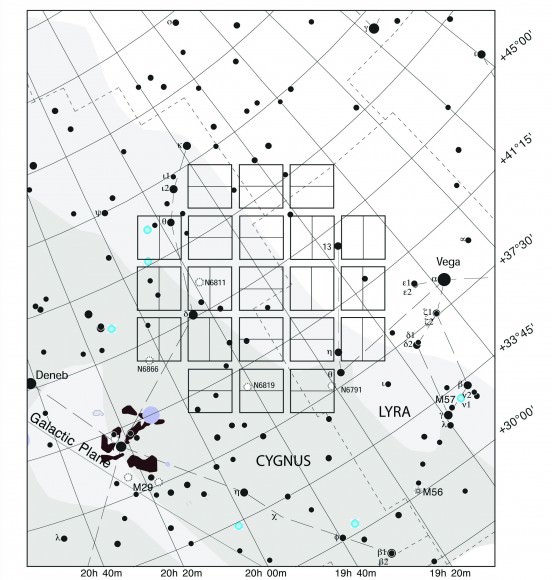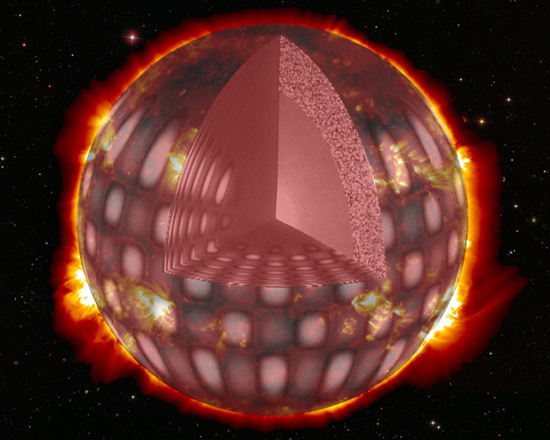[/caption]
This week, first results from the Kepler mission are coming out in waves from the meeting of the American Astronomical Society (AAS) in Washington, DC. Carried along on those waves are papers on waves in stars. I’m referring to a branch of astronomy you’ll be hearing more about as Kepler and other missions begin to reveal the interior structures of stars- asteroseismology. So, what is asteroseismology?
Seismology is the study of earthquakes on Earth. But more importantly to our discussion, it is the study of seismic waves. Earthquakes produce different types of seismic waves that travel through different layers of rock, providing us with a way to image structures deep within the Earth. Essentially, large earthquakes provide us with a natural sonogram to look inside the Earth, far deeper then we can tunnel or drill. Since these waves propagate all the way from one side of the planet to the other we can look all the way to the center of the Earth. This is how we know the outer core of the Earth is liquid, and the relative dimensions and densities of the other parts of the Earth’s internal and surface structure.

Asteroseismology, also known as stellar seismology, gives us the same kind of insight into the structure of stars. By studying the oscillations in pulsating stars, astronomers can peer into the very hearts of stars, one of the most difficult places to observe in the entire universe. The reason stellar interiors can be probed from oscillations is that different oscillation modes penetrate to different depths inside the star. Combining the rate, and amplitude of pulsation with other information, such as spectra, which reveals what the composition of the star is we obtain information on the internal structure of stars.
Stellar oscillation modes are divided into three categories, based on the force that drives them: acoustic, gravity, and surface-gravity wave modes. p-mode, or acoustic waves, have pressure as their force, hence the name “p-mode”. These waves can tell us things about the structure and density of regions below the surface of a star. g-mode, or gravity waves, are confined to the interior of the star. f-mode, or surface gravity waves are also gravity waves, but occur at or near the outer layers of stars, so they give us information about the surface conditions of stars.
Helioseismology is the study of the propagation of wave oscillations in the Sun. Since the Sun is the closest star to us, it is much easier to study its pulsations in greater detail. By interpreting solar oscillations we can even detect sunspots on the far side of the Sun before they rotate into view. Many of our models of stellar interiors are based on information gained through studying the Sun’s oscillations. But the Sun is only one star at one point in its evolution, so to really understand stars we need to observe many more stars of different size, mass, composition and age.

That is precisely what Kepler is doing right now. The satellite is staring at a 100 square degree section of the sky between Cygnus and Lyra continuously taking data on the brightness of over 150,000 stars for the next three to five years. While Kepler’s primary mission is to discover the existence and abundance of earth-like planets around stars, all this high precision photometry will be used for other science, especially studying variable stars of all types and performing asteroseismology on stars showing solar-like oscillations.
The much-anticipated release of the first science results from the Kepler mission January 4th, included numerous papers on asteroseismology and the potential for understanding stellar structure in unprecedented detail. Astronomers are riding the new wave of information on wave propagation in stars. Surf’s up!
Further reading:
The asteroseismic potential of Kepler: first results for solar-type stars
W. J. Chaplin, T. Appourchaux, Y. Elsworth, et al
http://arxiv.org/abs/1001.0506
Solar-like oscillations in low-luminosity red giants: first results from Kepler
T. R. Bedding, D. Huber, D. Stello, et al
http://arxiv.org/abs/1001.0229
Kepler Asteroseismology Program: Introduction and First Results
Ronald L. Gilliland, T. M. Brown, J. Christensen-Dalsgaard
http://arxiv.org/abs/1001.0139


I know I’m odd, but I’m glad that Keppler can be used for something besides planethunting. This is more interesting for some reason. (I guess it goes back to that quip about all science being “either physics or stamp collection”.)
The ancients very nearly got it right. It wasn’t the static picture of harmony of spheres, it is the dynamic picture of spherical harmonics.
Sili, what isn’t physics in planet system formation and dynamics? Presumably Kepler will also point the way to telescopes that will map planetary physics in more details.
Since no one has mentioned this…
At the second paragraph:
That should be than, not “then”.